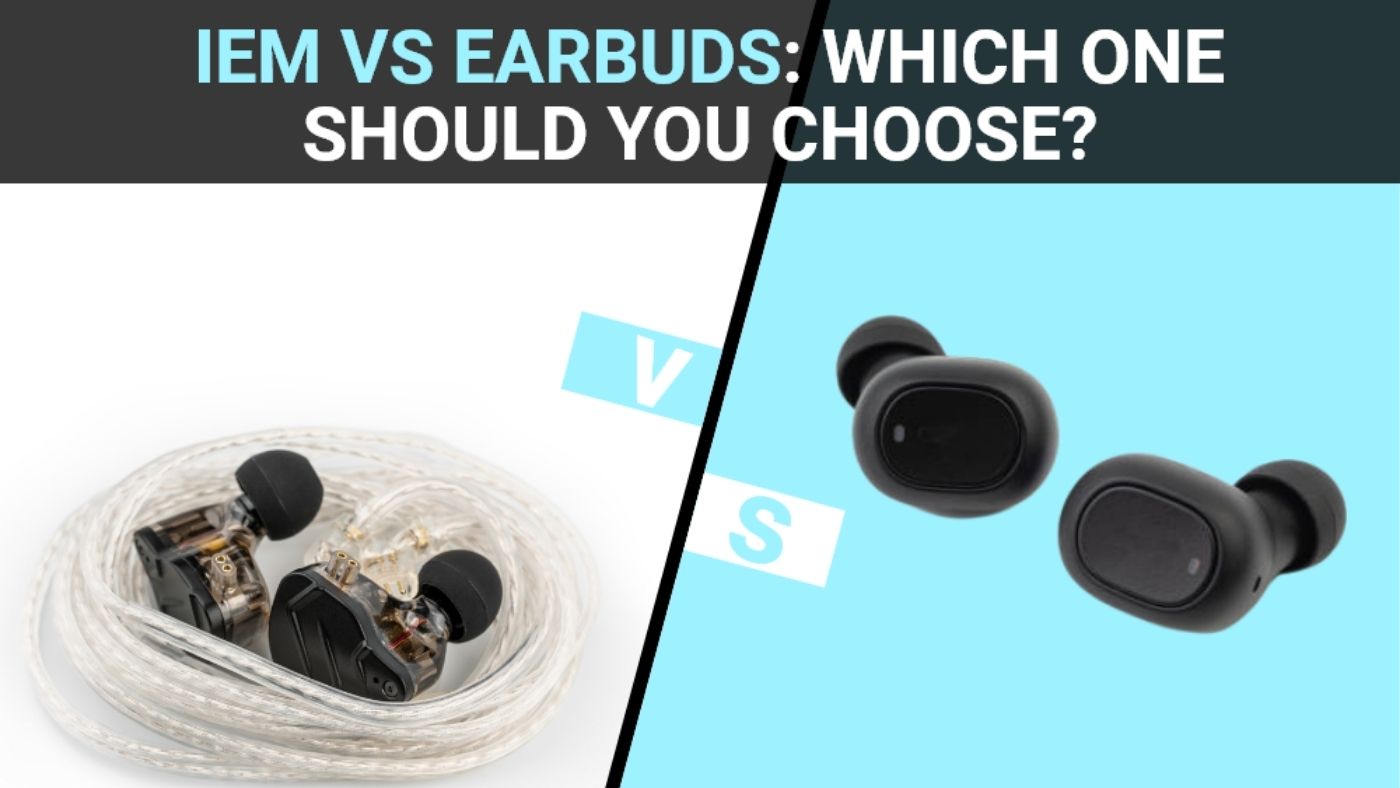The debate between over-ear, in-ear monitors (IEMs), and earbuds has been ongoing for quite some time. Many music enthusiasts swear by their preferred audio equipment choice, touting each technology's advantages over its competitor. With an array of features to choose from and conflicting opinions competing for attention around the web, it can be challenging to assess which technology is best for you and your particular needs. We've done the research and put together our findings on IEMs versus earbuds so that you can make a more informed decision when selecting your next set of personal audio products.
There is a lot to consider when picking out headphones and listening devices. Do you go for (IEMs) or settle for earbuds? Investing in (IEMs) can give you the ultimate sound experience, allowing you to enjoy music exactly as the artist intended. While (IEMs) typically cost more than earbuds, they will last much longer and can provide superior sound quality. Choosing the right option also depends on lifestyle. (IEMs) are ideal for those with an active lifestyle, whereas earbuds might be more suitable if your main priority is affordability and portability. Considering all these considerations ensures that the perfect audio device can be selected.
IEMs vs. Earbuds

The debate between (IEMs) (In-Ear-Monitors) and earbuds has been going on for some time. It is ultimately a personal preference, but IEMs generally offer superior sound quality due to their custom-fit design.
They can provide better isolation from the outside world, creating an immersion into the soundscape that traditional earbuds don't offer. On the other hand, earbuds are more versatile and portable by providing a lighter design and have no leakage, making them perfect for listening in public environments or while traveling.
Although sound quality may be slightly compromised, this makes them ideal for casual listening, all of which are factors considered when choosing between (IEMs) vs. earbuds.
A. Explanation of IEMs
In-ear monitors (IEMs) are audio devices that allow users to have a personal listening experience with various audio sources. Professional musicians typically use IEMs during performances as they can provide enhanced sound clarity and accuracy and improved comfort compared to traditional earphones or headphones. They work by providing a custom fit with their silicone or foam tips that create an acoustic seal in the ear canal. This helps to minimize external sound interference and creates an optimal environment for better sound reproduction.
1. Benefits of IEMs
In-ear monitors (IEMs) are a precious tool in any musician's life, offering several advantages over traditional headphones. IEMs sits directly inside the user's ear canal and deliver superior sound quality at lower volumes: This is more comfortable for the listener and helps protect hearing.
Additionally, IEMs provide greater control over noise cancellation and create a soundstage, which is essential when recording or performing live music. Furthermore, they come in various styles and price points so that you can find the perfect fit for your daily needs. Investing in good quality, IEMs offer significant benefits to musicians at any career stage.
2. Drawbacks of IEMs
IEMs (In-Ear Monitors), with their superior noise isolation and deep bass response, is popular among performers and audiophiles. However, increased in-ear pressure caused by the tight seal of IEMs can lead to distortion of sound at higher volumes and discomfort for extended listening sessions.
In addition, as any debris enters the earbud, your ears must be vigilant to clean it out, or it could cause potential physical damage to the ear canal. Furthermore, depending on its size and shape, fitting an IEM properly into the ear may take some time to get used to. All these factors have discouraged some from using IEMs altogether.
B. Explanation of earbuds
Earbuds are small, portable audio sources typically designed to fit within the ear canal. They provide a convenient alternative to over-the-ear headphones and large, bulky audio projection devices. Earbuds consist of one or more speakers (or drivers) encased in an insulated housing worn on a user's ears. Different designs include features like noise canceling or sound amplification that can be adjusted to suit the users' needs.
More advanced models include additional features such as Bluetooth connectivity and water/sweat resistance for increased durability. Their compact design makes earbuds easy to transport, making them extremely popular among modern users seeking more precise sound quality with little hassle or weight.
1. Benefits of earbuds
Earbuds offer a notable advantage compared to traditional headphones in that they are lightweight and compact, making them incredibly portable and ideal for listening to the audio on the go. Additionally, earbuds hit the sweet spot between delivering quality sound and still blocking out background noise. This makes them perfect for enjoying music or audiobooks without being distracted by daily life. Furthermore, as earbuds typically come with multiple sizes of silicon tips and wings, it's easier for you to find your perfect fit for a comfortable and secure fit. The benefits of earbuds make them a sensible choice for anyone seeking optimal sound and convenience.
2. Drawbacks of earbuds
Earbuds are growing in popularity as a convenient way to listen to audio, but they have some drawbacks. One of the significant issues is sound leakage: because earbuds sit directly inside your ear canal, they can leak sound that can be heard by those sitting nearby. This lack of sound isolation also means that ambient noises may be more distracting and prevent you from hearing audio content. Additionally, while many users switch out their ear tips and find size alternatives, a poor fit can lead to discomfort over long periods of listening or muffled sounds due to an improper seal. Finally, due to the snug nature of how earbuds fit within the casing of your ears, germs, and bacteria can accumulate on them more quickly than more giant over-ear headphones.
C. Comparison of IEMs and earbuds
In-ear monitors (IEMs) and earbuds are two popular headsets available on the market, but they differ in design and sound quality. IEMs involve inserting a pair of noise-isolating headphones into the ear while earbuds rest just outside of it. Sound-wise, IEMs provide greater acoustic accuracy and clarity compared to earbuds because they use silicone or foam tips that block out unwanted ambient noise. Meanwhile, earbuds have an open design, making them more comfortable and breathable but allowing external sounds to disrupt the listening experience. Ultimately, it comes down to choosing the right headset based on your needs – with IEMs providing superior audio quality in loud environments like concerts or live events. At the same time, earbuds are best used in quieter settings.
1. Sound quality
IEMs provide much higher sound quality due to their direct fitment that blocks out external noise, whereas earbuds allow for some external noise to filter in. This makes IEMs superior for critical listening and studio applications as they provide better detail and clarity than any other type of headphone.
2. Comfort
IEMs feature drivers mounted into a tiny housing that fits directly into the ear, while earbuds are generally smaller units placed just outside the ear canal.
3. Noise isolation
One of the most critical differences between In-ear Monitors (IEMs) and earbuds is noise isolation. IEMs come with either foam or silicone tips that sit snugly in the ear canal, creating a near-perfect seal. This provides much better sound quality overall, along with an added emphasis on bass tones and outside noise reduction by blocking off all but the music itself.
4. Portability
Especially regarding portability, IEMs tend to offer a fairly decent balance between sound quality, size, and convenience. Many models offer an ergonomic design that sits comfortably in one's ears, as well as noise-canceling technology for a quieter outdoor ambiance. On the other hand, earbuds are generally lighter and sleeker than IEMs but sacrifice sound quality somewhat in doing so.
Factors to consider when choosing between IEMs and earbuds

Here are some factors to consider when choosing between IEMs and Earbuds.
A. Personal preference
When it comes to choosing between IEMs (In-Ear Monitors) and earbuds, there are a few factors to take into consideration. Firstly, one should think about personal preference. Do you prefer the sound quality of IEMs or the convenience of earbuds? While IEMs are often seen as superior audio devices, those looking for portability may choose earbuds because of their smaller size and lightness.
B. Sound quality
When it comes to selecting an audio device, deciding between in-ear monitors (IEMs) and earbuds can be a difficult decision. Sound quality is a significant factor; IEMs often provide a more detailed listening experience due to their ability to fit better with the ear canal. Earbuds, on the other hand, offer better soundstage and can bring out some details that IEMs may miss, depending on your environment and preferences.
C. Comfort
comfortability should always be considered when choosing IEMs or earbuds, as wearing something for long periods can quickly become uncomfortable if not selected carefully.
D. Noise isolation
Another factor to consider is noise isolation; whether you want to hear your audio in loud environments or let your music envelop you in privacy is an important choice that can only be made by taking into account your own needs.
E. Portability
Portability is something that many people opt for when making their decision. Earbuds are usually limited in terms of sound performance and sound isolation but have a smaller size and weigh less than IEMs, making them easier to transport and store.
Therefore, when choosing an audio device between IEMs or earbuds, you should consider your personal preferences: sound quality or portability.
Conclusion
In this blog post, we have discussed the pros and cons of IEMs and Earbuds and highlighted four key factors to consider when choosing between them. As with any purchase decision, personal preference determines your best option.
However, if you are looking for the ultimate sound quality, comfort, noise isolation, and portability, then IEMs usually come out ahead.
Therefore, I strongly recommend taking a closer look at IEMs if you are ready to upgrade your audio experience. With all these considerations in mind, hopefully, you can make an informed decision that suits your needs – good luck!




1 comment
Bill
pretty informative, nice article,
pretty informative, nice article,